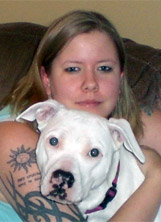Neurosurgeon: Gail L. Rosseau, MD, FAANS, Chicago Institute of Neurosurgery and Neuroresearch, Chicago
Patient: Lisa Klok, age 25, Chiari Malformation
Lisa Klok has a condition called Chiari malformation. Since the age of six, Lisa suffered from what doctors diagnosed as “classic” migraines. She lived with these headaches for 18 years until they became unbearable. The symptoms of Chiari can be very similar to a host of other conditions, making it challenging to diagnose. Patients with syringomyelia and Chiari Type 1 often present with an intense, burning-type nerve pain and/or chronic headaches, among other symptoms.
The prevalence in the general population has been estimated at slightly less than 1 in 1000. Chiari Type 1 malformation occurs during fetal development and is characterized by downward displacement, by more than four millimeters, of the cerebellar tonsils beneath the foramen magnum into the cervical spinal canal. This displacement may block the normal pulsations of cerebrospinal fluid (CSF) between the spinal canal and the intracranial space. This form of Chiari malformation may be associated with syringomyelia/hydromyelia. It is diagnosed more commonly in adolescents or adults.

Surgical treatment of Chiari depends on the type of malformation. The goal of surgery is to relieve or stop the progression of the syrinx and/or symptoms by decompressing nerve tissue and restoring normal flow of CSF around and behind the cerebellum. Decompression provides more space for the brain stem, spinal cord and descended cerebellar components.
In Lisa’s Own Words
My story starts at the age of six when I was diagnosed with “classic” migraines. Sometimes they weren’t bad, but other times they were terrible. By the summer of 2008, I was spending four nights a week in the emergency room due to the pain. I had no life, no hope and any money I made from my job went to ER co-pays. I lived with my mother, and all she did was take care of me, driving me back and forth to the hospital. Then someone recommended the Diamond Headache Clinic in Chicago.
I traveled from Kalamazoo to the clinic and began inpatient treatment for a week. They taught me new ways to manage migraines and break this cycle, along with ordering multiple tests. An MRI revealed that I had Chiari malformation. I was referred to Gail L. Rosseau, MD, a neurosurgeon at the Chicago Institute of Neurosurgery and Neruoresearch (CINN).
After I read about this condition, all of the symptoms I had been experiencing now made sense. In discussing my situation with Dr. Rosseau, we decided together that I should have surgery. On Sept. 28, 2008, Dr. Rosseau performed Chiari decompression with a suboccipital craniectomy, C1 laminectomy and duraplasty.
More than a year has passed and life is amazing! My headaches are not completely gone – certainly not perfect – but they have decreased by about 80 percent. I still get bad ones on occasion, but unlike before, now my medication works. I have only been to the ER three times in the past year, compared to 3-4 times a week in the year prior to surgery. I know that would still be a lot of ER visits for some people, but for me, it’s amazing! Along with my short-term medications, I am on preventatives, and they are working.
In September 2009, I finally moved out. I live on my own, and I’m able to go to work the vast majority of the time. I do not have to depend on anyone else to take care of me. I love my life, and I have never been happier! I got a puppy and her name is Nelly. I love her very much, and I am happy that I have the opportunity to live the life I do now – it is like a dream come true. I want everyone to know that there is always hope. I know it is very easy to lose hope, and hard to get it back, but just keep trying.
Note from AANS
The AANS does not endorse any treatments, procedures, products or physicians referenced in these patient fact sheets. This information is provided as an educational service and is not intended to serve as medical advice. Anyone seeking specific neurosurgical advice or assistance should consult his or her neurosurgeon, or locate one in your area through the AANS’ Find a Board-certified Neurosurgeon online tool.
